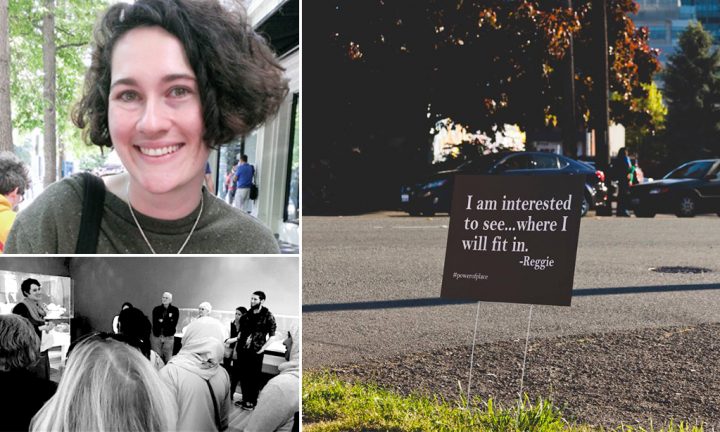Aletheia Wittman cofounded and coordinates The Incluseum, a project that advances new ways of being a museum through community building and collaborative practice related to social justice in museums. Wittman is also Exhibit and Public Programs Manager at the Seattle Architecture Foundation (SAF) and collaborates with SAF volunteers and community partners to develop programs that connect Seattle architecture and design to people of all ages. She has worked with the Henry Art Gallery, the Ballard Historical Society, Access Art Gallery in Vancouver, BC, and as a Social Media Specialist for 4Culture’s Creative Justice program. Aletheia has an MA in Museology from the University of Washington where she researched emerging curatorial practices in art museums and their relationship with social justice.
Q: Design Change Is…
A: Intentionally initiating and stewarding social change processes that are rooted in collaboration, liberation and compassion so that the impact of such change advances the quality of our lives.
Q: What’s the big opportunity for Design in Seattle?
A: Design is more widely understood today as a set of tools with principles that can be engaged, and have been engaged throughout human history, not only by professionals but by all of us in our everyday lives. This demystification is due to increasing recognition of the value of a wide range of cultural and scientific practices as design. It can also be attributed to the work of design ambassadors, organizations and entrepreneurs that span disciplines and communities, and who make it their priority to put design in better service to society. Demystifying the discipline does not require that we discount the role of the skilled professional, or Designer, who excels in the discipline and their role in disciplinary leadership. The demystification of design is a real opportunity.
While many design decision-making bodies still operate in inaccessible ways, disproportionately so for people who have been systematically excluded, the perception shift toward democratizing design is powerful. Communities are seeing design as a means to achieve their self-determined purposes and priorities. We could replace “design” with “art” and have the same conversation, but lines between design and art are blurry for me.
Q: There is an Italo Calvino quote: “A world without forgetting is hell.” How do you balance an understanding of tradition, institutional memory and wisdom with the necessity of forgetting things and moving on in order to achieve progress? Is there anything new left to do?
A: As someone who works with museums and also writes about museums becoming more equitable and just, this statement brings up a lot for me. Museums have at times been both “worlds without forgetting” and “worlds of selectively forgetting.” Each of these intersecting roles needs to be challenged. The museum should neither be a static repository that accumulates memories and things, with value determined by a limited and biased canon of scholarship, nor should they perpetuate the systematic erasure of colonialism, racism and elitism that often brought them into being. Engaging institutional memory and genealogies of these legacies in museums is key to addressing institutions’ responsibility to address painful pasts alongside liberation movements today so they can move forward with reconciliatory actions. “Remembering” functions in multiple ways in museums. Designing or discerning the best ways to be museums in the future requires considering this dynamic in great depth.
So, what of the tradition of the Museum should continue? What is that part that resonates with and serves us all? And what should we lose in the service of progress?
Museums are the stewards of stories as told by material and immaterial culture. In museums we can experience connections to otherwise seemingly distant times, places or ideas that open doors to developing our own understanding of the world. Museums institutionalize the practice of stewarding material and immaterial culture and have the social and economic power to be the dominant, but not the only or most important, form of cultural stewardship.
By virtue of the ways in which they work to bring living context to stories – outside of their time, place, or an everyday setting – museums have the potential to play a powerful role in our understanding of ourselves and the world around us. However, Museums emerged on the scene of cultural stewardship at a fairly recent date. They gained dominance as a European formation; entwined with the projects of accumulating individual wealth and power as well as with nationalism and empire building. Today, museums are iconic cultural stewards in European society, as well as the Americas, Africa, Australia and Asia.
Museums have never been a monolithic formation, not only because each individual museum adapts to and operates within a host of national and local contexts, but because of the external pressure exerted by their publics. As communities organizing around issues of identity, exclusion and oppression make their voices heard, forcing ideas of who-the-public-is to be reconstituted, museums must come to terms with the ways the historic model for stewardship has been entwined in structures that communities call to dismantle in pursuit of a more just and equitable society.
United States museums have had the privilege to choose whether or not to ignore the ways communities vote for museum ineffectiveness by not visiting. The organizing work of people of color, LGBTQ, low-income people, disabled individuals, or other marginalized groups cannot afford the time to wait for museums to acknowledge the value of their work. Though, when museums are called into dialogue and partnership with communities organizing around their own liberation, and they often are, museums are being given an amazing opportunity. They are invited to redesign the museum as a better, more intersectional formation, and to reject a paradigm where a museum experience or job is at odds with the communities whose culture and history they collect or have excluded.
There is much work left to be done.





